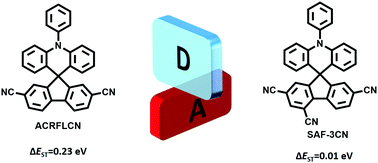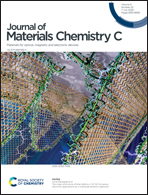Acceptor modulation for improving a spiro-type thermally activated delayed fluorescence emitter†
Abstract
A novel donor (D)–spiro-acceptor (A) emitter, namely 10-phenyl-10H-spiro[acridine-9,9′-fluorene]-2′,4′,7′-tricarbonitrile (SAF-3CN), was synthesized for high efficiency, yellowish green third-generation thermally activated delayed fluorescence (TADF) organic light-emitting diodes (OLEDs). The CN-modulation of the fluorene was adopted for the modification of the singlet state with minor modifications of the triplet state. Compared to the reference material 10-phenyl-10H-spiro[acridine-9,9′-fluorene]-2′,7′-dicarbonitrile (ACRFLCN), the electron-withdrawing –CN substituent on the C4 site of the fluorene results in a sufficiently small singlet–triplet energy gap (ΔEST) and obvious TADF characteristics of SAF-3CN in the doped films. Encouragingly, the device performance achieves an external quantum efficiency (EQE) of 19.4% and small roll-off, which is better than that of ACRFLCN and closer to the best performance in this system.



 Please wait while we load your content...
Please wait while we load your content...